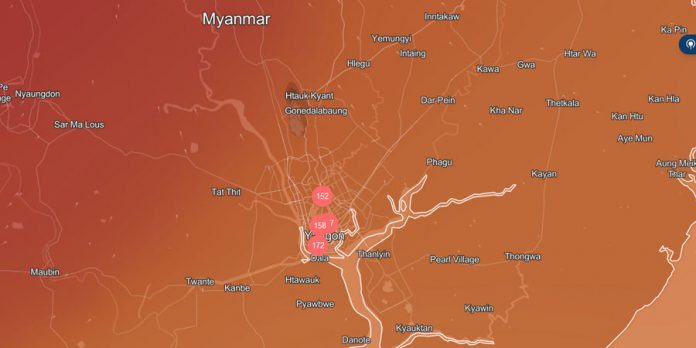FROM THE DVB NEWSROOM
Myanmar’s largest city, Yangon, is grappling with hazardous air pollution, according to IQAir, a global air quality monitoring group. Pollution levels have escalated into the red category, posing a significant health risk for residents.
The data is collected from air quality monitoring stations at five key locations, including the Thai and U.S. embassies. The air quality index (AQI) reached 160 on March 18, surpassing previous days’ levels and showing a rapid increase within hours.
Specifically, the average concentration of PM2.5 (particulate matter with a diameter of 2.5 micrometers or smaller) in Yangon’s air exceeds the World Health Organization (WHO) standard by a staggering 14 times.
To put this in perspective, historical air quality records from 2019 show that Yangon’s PM2.5 levels were once at the upper limit of the ‘moderate’ range. But since 2018, a dedicated team called Air Quality Yangon (AQY) has been tracking the city’s air pollution.
By December 2019, the air quality had deteriorated to levels considered detrimental to health.
“Our primary focus is on measuring the concentration of particles in the air that can impact health. These particles are minuscule, approximately 25 times smaller than a strand of hair, making them easily breathable without notice,” said Ma Thae Su Su Tun, a member of AQY.
The ‘red’ level on the air quality scale, which ranges from 151-200, signifies a health hazard for all population groups. In contrast, levels from 0-50 are deemed excellent, and 51-100 are acceptable. A range of 101-150 is considered unhealthy for sensitive individuals but is generally not perceived as a threat to the public’s health.
IQAir attributes Yangon’s air pollution to a variety of factors. These include the use of low-quality fuel by motorcycles and diesel-powered vehicles, lax regulations regarding vehicle emissions, the habitual burning of garbage and organic waste, along with crop field burning.
Additionally, poorly maintained construction sites and road repair activities also play a role in exacerbating the issue. The city’s air pollution peaks from October to May, with February and March marked as periods of particular concern.
In a global context, Yangon’s struggle is not isolated. Lahore, Pakistan currently holds the dubious distinction of being the most polluted city with an AQI of 216, closely followed by Delhi, India at 211.
Chiang Mai, Thailand and Kathmandu, Nepal also grapple with high pollution levels, recording AQIs of 192 and 178, respectively. Karachi, Pakistan and Dhaka, Bangladesh are not far behind, each with an index of 169.
The impact of air pollution is a grave global health concern. IQAir’s research indicates that air pollution is a contributing factor in the deaths of seven million people annually. In stark contrast, Stockholm, Sweden is recognized as the cleanest city in the world, setting a benchmark for air quality standards.



